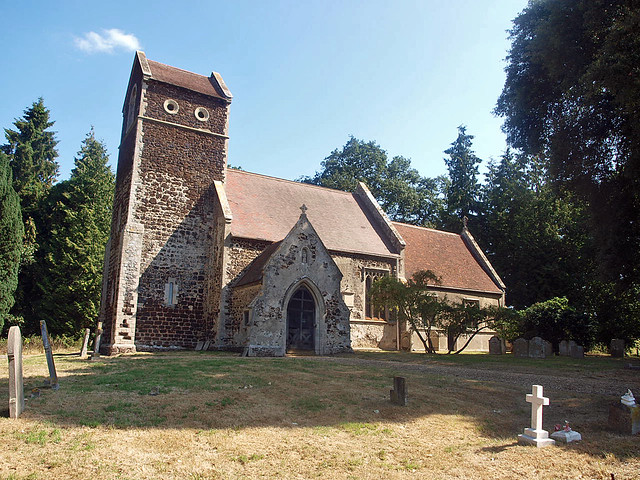As an aside, it took me two goes to find it as the postcode cited by a achurchnearyou is wildly inaccurate and all others I found on the web were also off mark, so if you put PE38 0DR [achurchnearyou offering] in your satnav and are coming up the A10 from the south, ignore the two left hand turns to Denver and take the next right [signposted to Ryston] and drive for about 150 yards - the church is on your right in woods. If coming from the north cross the roundabout and take the first left.
ST MICHAEL. Of carstone. The W tower alas is of 1858, but the tower arch is Norman. Early C14 S doorway. Straight-headed Perp nave windows. In the chancel two small low-side windows and a big three-light Dec window with flowing tracery. Piscina with a little bit of pretty tracery. - MONUMENTS. Lady Pratt, widow of Sir Roger Pratt d. 1706. Semi-reclining figure in contemporary dress; no back architecture. - Pleasance Pratt d. 1807. By John Bacon jun., with charming groups of small figures by and below an urn.
RYSTON. There is an oak here more important than the beautiful park to which it belongs, for it is Kett’s Oak, one of several associated with the ill-fated rising of the peasants under the tanner of Wymondham which was so cruelly crushed in 1549. Other such oaks have been called Oaks of the Reformation, because Kett’s followers were believed to have met under them. Ryston’s Oak, still vigorous, is authentic.
The hall was built in the 17th century by Sir Roger Pratt, and is still the home of this family, whose many generations here extend beyond the time of the Reformation. The same Sir Roger, sleeping in the chancel, gave the nave of the church a tiled roof for its thatch. Their arms and crest (a little man in red and gold) are on the marble tomb where Lady Pratt, with curled locks, lies in an embroidered nightdress.
The church is by the wayside across the park from the Oak. Great trees keep it company, and a splendid cedar overtops the brick saddleback tower which, though made new after being long in ruins, has still its low Norman arch and three Norman windows. Old doors open to the simple candle-lit interior, and black and white roofs look down on the nave and chancel, the nave roof modern and the chancel’s 15th century. There are two low windows, a pretty corner piscina, an aumbry with finely carved doors, and a font which may be 16th century.
The hall was built in the 17th century by Sir Roger Pratt, and is still the home of this family, whose many generations here extend beyond the time of the Reformation. The same Sir Roger, sleeping in the chancel, gave the nave of the church a tiled roof for its thatch. Their arms and crest (a little man in red and gold) are on the marble tomb where Lady Pratt, with curled locks, lies in an embroidered nightdress.
The church is by the wayside across the park from the Oak. Great trees keep it company, and a splendid cedar overtops the brick saddleback tower which, though made new after being long in ruins, has still its low Norman arch and three Norman windows. Old doors open to the simple candle-lit interior, and black and white roofs look down on the nave and chancel, the nave roof modern and the chancel’s 15th century. There are two low windows, a pretty corner piscina, an aumbry with finely carved doors, and a font which may be 16th century.

No comments:
Post a Comment